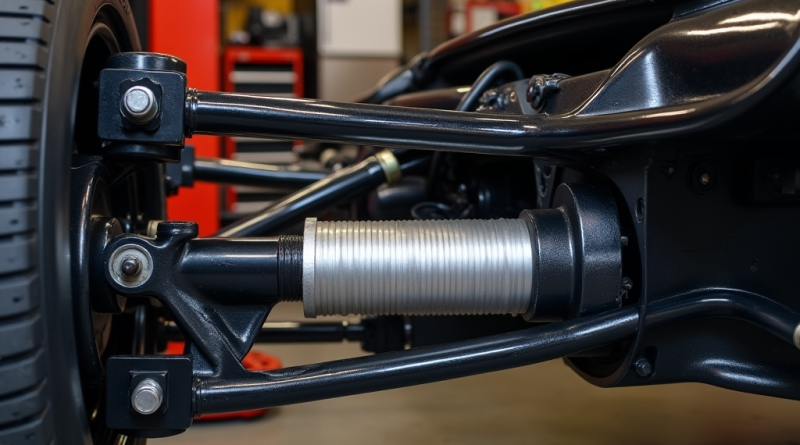Optimizing Your 1992 Corvette: Understanding the Rear Monospring Mount Pad Spacer
The 1992 Corvette, part of the renowned C4 generation, has long been celebrated for its performance, sleek design, and innovative engineering. Over the years, car enthusiasts have looked for ways to optimize and enhance the handling of their Corvettes, focusing on specific components that make a significant impact. One such component is the rear monospring mount pad spacer, a critical yet often overlooked part of the suspension system.
In this article, we’ll explore everything you need to know about the 1992 Corvette rear monospring mount pad spacer, including its purpose, installation process, benefits, and how it can improve your Corvette’s overall performance.
Understanding the Rear Monospring in the 1992 Corvette
Before diving into the details of the mount pad spacer, it’s essential to have a basic understanding of the monospring system used in the 1992 Corvette. Unlike traditional coil springs, the C4 Corvette utilizes a transverse fiberglass monospring in both the front and rear suspension setups. This design reduces weight, improves ride quality, and helps lower the center of gravity, providing better handling characteristics.
The rear monospring supports the rear suspension, balancing the vehicle’s weight and allowing for more precise control over the car’s movement. It plays a significant role in maintaining ride height and overall suspension dynamics.
However, as the Corvette ages, various suspension components, including the rear monospring, may require attention, adjustment, or replacement. This is where the rear monospring mount pad spacer comes into play, offering a practical solution for maintaining or modifying suspension height and performance.
What is a Rear Monospring Mount Pad Spacer?
The rear monospring mount pad spacer is a small, yet crucial part of the suspension system. It is installed between the monospring and its mounting points, effectively adjusting the distance between the spring and the chassis. The spacer serves several purposes:
- Height Adjustment: Adding or removing spacers can adjust the rear ride height of the vehicle. This can be particularly useful if you’re looking to fine-tune the stance or accommodate larger wheels and tires.
- Improved Handling: By altering the rear suspension geometry, the spacer can influence how the car handles under different driving conditions. It can reduce body roll and improve cornering stability.
- Enhanced Ride Comfort: Adjusting the rear ride height can also have a direct impact on ride quality. Drivers can use spacers to soften or stiffen the suspension depending on their preference.
While the rear monospring mount pad spacer might seem like a minor component, it plays a vital role in achieving the perfect suspension setup for your Corvette.
Why Use a Rear Monospring Mount Pad Spacer?
There are several reasons Corvette owners might choose to install a rear monospring mount pad spacer:
- Suspension Sag: Over time, the monospring can lose its tension, leading to a sagging rear end. This affects not only the car’s aesthetics but also its handling and performance. A mount pad spacer can help restore the car’s original ride height.
- Performance Tuning: For Corvette owners who enjoy track days or spirited driving, optimizing the suspension for better cornering, braking, and acceleration is crucial. Using spacers allows for precise ride height adjustments that can enhance performance.
- Customizing Ride Height: Some owners prefer a lower or higher stance for aesthetic reasons. A mount pad spacer provides the flexibility to achieve the desired look without compromising suspension integrity.
- Accommodating Larger Tires: If you’ve upgraded to larger wheels or tires, the rear suspension may need to be adjusted to prevent rubbing or clearance issues. A spacer can create the necessary gap to accommodate these changes.
Installing the Rear Monospring Mount Pad Spacer
Installing a rear monospring mount pad spacer is a relatively straightforward process, but it does require some mechanical know-how and the right tools. Here’s a general guide on how the installation process works:
Tools You’ll Need:
- Floor jack
- Jack stands
- Torque wrench
- Ratchet and socket set
- Pry bar or spring compressor (if needed)
- Rear monospring mount pad spacer kit
Step-by-Step Installation Guide:
- Prepare the Vehicle: Begin by parking your Corvette on a level surface. Use a floor jack to lift the rear of the vehicle, and secure it with jack stands. Ensure the car is stable before proceeding.
- Locate the Rear Monospring: The rear monospring runs transversely (side to side) across the rear of the vehicle. You’ll find the mounting points where the spring attaches to the frame and suspension.
- Remove the Mounting Bolts: Using a ratchet and socket set, carefully remove the bolts securing the monospring to its mounts. Be sure to note the torque specifications for reinstallation.
- Install the Spacer: With the bolts removed, install the mount pad spacer between the monospring and its mounting point. Ensure the spacer is seated correctly and evenly on both sides.
- Reassemble the Suspension: Once the spacer is in place, reinstall the mounting bolts and torque them to the manufacturer’s specifications. Double-check that everything is properly aligned.
- Lower the Vehicle and Test: After installation, carefully lower the vehicle and take it for a test drive. Pay attention to any changes in ride height, handling, and comfort.
Choosing the Right Spacer for Your 1992 Corvette
When selecting a rear monospring mount pad spacer for your 1992 Corvette, there are a few key factors to consider:
- Spacer Thickness: The thickness of the spacer will determine how much the ride height is altered. Thicker spacers will raise the rear of the car, while thinner spacers will have a more subtle effect.
- Material: Spacers are typically made from durable materials like aluminum or high-density polyurethane. Both options are long-lasting, but aluminum spacers tend to be more rigid, while polyurethane offers a bit more flexibility.
- Compatibility: Ensure that the spacer you choose is specifically designed for the 1992 Corvette’s rear monospring suspension system. Using a part that isn’t compatible can lead to improper installation or performance issues.
Common Issues with Rear Monospring Mount Pad Spacers
While rear monospring mount pad spacers can provide significant benefits, there are also some common issues Corvette owners should be aware of:
- Alignment Problems: Adjusting the rear ride height can sometimes throw off the vehicle’s alignment, leading to uneven tire wear or handling issues. It’s recommended to get an alignment check after installing spacers.
- Excessive Stiffness: Adding too many spacers or using thick spacers can stiffen the rear suspension to an undesirable level, negatively affecting ride comfort.
- Installation Errors: Improper installation, such as incorrect torqueing of bolts or misaligned spacers, can cause suspension problems or even damage the monospring.
Benefits of Installing Rear Monospring Mount Pad Spacers
- Enhanced Performance: By optimizing the rear suspension height and geometry, the mount pad spacer improves handling, stability, and responsiveness, especially during cornering and high-speed maneuvers.
- Customizable Ride Height: One of the key advantages of using a mount pad spacer is the ability to fine-tune the ride height of your Corvette. Whether you’re looking for a lowered, aggressive stance or simply need to restore factory ride height, spacers provide flexibility.
- Prolonged Suspension Life: Adding a spacer can help reduce wear and tear on the monospring by ensuring that the rear suspension remains properly aligned and balanced.
- Cost-Effective Solution: Instead of replacing an entire monospring system, installing spacers offers a more affordable way to address suspension sag or performance issues.
Maintenance Tips for Rear Monospring Mount Pad Spacers
To keep your rear monospring and mount pad spacers in optimal condition, consider the following maintenance tips:
- Regular Inspections: Check the spacers and mounting points periodically for signs of wear, corrosion, or damage. Replacing worn spacers early can prevent more significant suspension problems.
- Proper Lubrication: Ensure that the suspension components, including the mount pads and spacers, are properly lubricated to reduce friction and extend their lifespan.
- Alignment Checks: Whenever you install or adjust spacers, have the vehicle’s alignment checked to ensure proper handling and tire wear.
Conclusion
The rear monospring mount pad spacer is a simple yet effective way to optimize the suspension on your 1992 Corvette. Whether you’re looking to restore the factory ride height, improve handling, or enhance your car’s overall performance, spacers provide a flexible and cost-effective solution. Understanding the purpose, installation process, and benefits of these spacers can help you make informed decisions about your Corvette’s suspension system, allowing you to enjoy the perfect balance between performance and comfort.
7 Frequently Asked Questions (FAQs)
- What are the signs that my 1992 Corvette needs a rear monospring mount pad spacer?
- If your Corvette’s rear end is sagging, or if you notice handling issues like excessive body roll, a mount pad spacer might be necessary to restore ride height and improve performance.
- Can I install the mount pad spacer myself, or should I take it to a mechanic?
- While mechanically inclined individuals can install the spacer themselves, it’s recommended to have a professional do the job, especially if you’re unfamiliar with suspension work.
- How do I know what spacer thickness to choose for my Corvette?
- The thickness depends on how much you want to adjust the ride height. Thicker spacers raise the car more, while thinner ones offer subtle changes. It’s best to consult with a suspension expert.
- Will adding a spacer affect my Corvette’s alignment?
- Yes, installing a spacer can affect the alignment of your Corvette. It’s advisable to have an alignment check after the installation to avoid issues like uneven tire wear.
- Are aluminum or polyurethane spacers better?
- Both materials have their advantages. Aluminum spacers are rigid and durable, while polyurethane offers some flexibility and vibration dampening. The choice depends on your driving style and preferences.
- Do rear monospring mount pad spacers affect ride comfort?
- Yes, adjusting the ride height with spacers can impact ride comfort. Depending on the thickness of the spacer, the suspension may feel stiffer or softer.
- How often should I check or replace the rear monospring mount pad spacer?
- It’s a good idea to inspect the spacer during regular maintenance, especially if you notice changes in ride height or handling. Replacement may be needed if the spacer shows signs of wear or damage.




